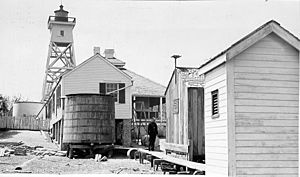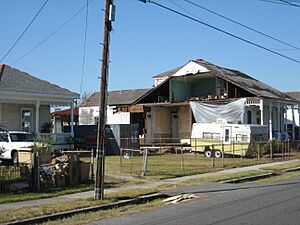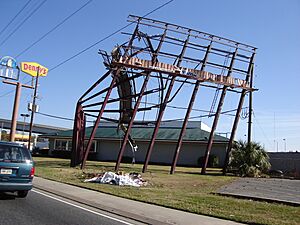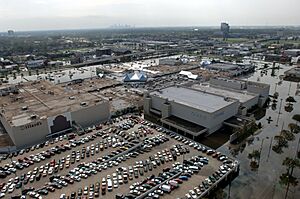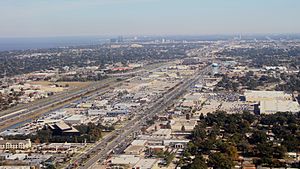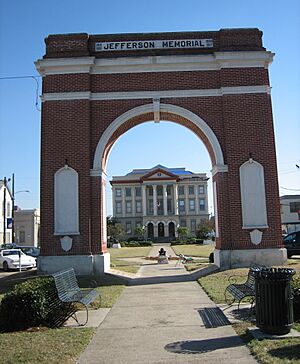Jefferson Parish, Louisiana facts for kids
Quick facts for kids
Jefferson Parish
|
||
|---|---|---|

City Hall in Gretna
|
||
|
||
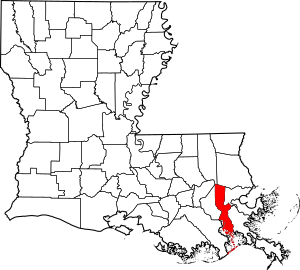
Location within the U.S. state of Louisiana
|
||
 Louisiana's location within the U.S. |
||
| Country | ||
| State | ||
| Founded | February 11, 1825 | |
| Named for | Thomas Jefferson | |
| Seat | Gretna | |
| Largest community | Metairie | |
| Area | ||
| • Total | 665 sq mi (1,720 km2) | |
| • Land | 296 sq mi (770 km2) | |
| • Water | 370 sq mi (1,000 km2) 56% | |
| Population
(2020)
|
||
| • Total | 440,781 |
|
| • Density | 660/sq mi (250/km2) | |
| Time zone | UTC−6 (Central) | |
| • Summer (DST) | UTC−5 (CDT) | |
| Area code | 504,985 | |
| Congressional districts | 1st, 2nd, 6th | |
Jefferson Parish is a special kind of county in the U.S. state of Louisiana. It's named after U.S. President Thomas Jefferson. In 2020, about 440,781 people lived here. The main government office, called the parish seat, is in Gretna. The biggest community is Metairie, and the largest city is Kenner. Jefferson Parish is part of the larger New Orleans area.
Contents
Exploring Jefferson Parish's Past
How Jefferson Parish Began
Jefferson Parish was created on February 11, 1825. It was named to honor Thomas Jefferson, who was the third U.S. President. You can even see a bronze statue of him in Gretna, where the main government buildings are.
When it was first formed, Jefferson Parish was much bigger. It stretched from New Orleans all the way to the St. Charles Parish line. But over time, as New Orleans grew, it took over some of Jefferson Parish's towns. These towns became part of Orleans Parish. The current borders between Jefferson Parish and Orleans Parish were set in 1874. That's also when Gretna became the parish seat.
Growth and Change from 1940 to 2000
From the 1940s to the 1970s, many families moved to Jefferson Parish from New Orleans. They were looking for more space and new homes. The population of the parish grew very quickly during these years.
New neighborhoods were built on the Eastbank of Jefferson Parish, often called "East Jefferson." These areas were easy to reach thanks to new roads like Veterans Highway and later I-10. On the Westbank, known as "West Jefferson," big new communities started to appear after the Greater New Orleans Bridge was built in 1958.
Over time, Jefferson Parish became more than just a place where people lived and worked in New Orleans. It started to have many jobs and businesses of its own. Areas like the Causeway Boulevard corridor became centers for offices, and the Elmwood area grew into a hub for factories and distribution. Today, Jefferson Parish is still a major shopping area for the entire New Orleans region.
Hurricane Katrina's Impact in 2005
In August 2005, Hurricane Katrina hit Jefferson Parish hard. On the East Bank, there was a lot of flooding and wind damage. Schools were also badly damaged. The West Bank had less flooding but still suffered from strong winds. Because of the storm, the parish government temporarily moved its operations.
After the storm, many parts of Jefferson Parish recovered quickly. The parish's flood protection systems, like levees and floodwalls, mostly held strong. This helped water to be pumped out faster. By October 2006, Jefferson Parish had largely recovered from Hurricane Katrina. Many people who had left during the storm began to return.
Flooding Challenges During Katrina
Some areas on the East Bank experienced flooding because the stormwater pumps were turned off during the storm. This meant that rainwater and storm surge water stayed on the streets and in homes for a day and a half. Many homes that were not damaged by wind still had severe flood damage. Officials have since made plans to improve how they evacuate important workers and manage pumping stations during future storms.
Another area, Old Metairie, flooded because it relied on New Orleans' drainage system, which failed. This caused deep water damage to many expensive homes. Plans are being considered to improve drainage in this area.
Life After Katrina
By April 2007, Jefferson Parish was leading the nation in job growth. This showed how well the area was rebuilding after Hurricane Katrina. The parish president believed that Jefferson Parish would soon have as many people as before the hurricane, or even more. This was because people who had moved out of New Orleans were returning to Jefferson Parish to be closer to their homes while they waited for help to repair them.
Geography and Natural Areas
Jefferson Parish covers about 665 square miles. More than half of this area (56%) is water, including parts of Lake Pontchartrain to the north. The mighty Mississippi River flows through the middle of the parish.
Jefferson Parish is surrounded by other parishes. To the north across Lake Pontchartrain is St. Tammany Parish. To the west is St. Charles Parish. To the east is Orleans Parish. And to the southeast is Plaquemines Parish. Much of the southern part of Jefferson Parish is made up of marshland, except for towns like Grand Isle.
Protected Natural Spaces
Jefferson Parish is home to some important natural areas:
- Jean Lafitte National Historical Park and Preserve (a part of it is in Marrero)
- Bayou Segnette State Park
- Grand Isle State Park
Neighboring Parishes
- Orleans Parish (east)
- St. Bernard Parish (east)
- Plaquemines Parish (east)
- Lafourche Parish (west)
- St. Charles Parish (west)
- St. Tammany Parish (north)
Towns and Communities
Jefferson Parish has several cities, towns, and other communities:
Cities
- Gretna (this is where the parish government is located)
- Harahan
- Kenner (the largest city in the parish)
- Westwego
Towns
Other Communities
- Avondale
- Barataria
- Bridge City
- Elmwood
- Estelle
- Harvey
- Jefferson
- Lafitte
- Marrero
- Metairie
- River Ridge
- Terrytown
- Timberlane
- Waggaman
- Woodmere
- Crown Point
Who Lives in Jefferson Parish?
In 2020, about 440,781 people lived in Jefferson Parish. The population has changed over the years. For example, between 2000 and 2010, the total population went down a bit. However, the number of Hispanic and Latino residents increased. This might be because many Hispanic and Latino people came to the area after Hurricane Katrina in 2005 to help with rebuilding.
Jefferson Parish is a diverse place. In 2020, about 47% of residents were non-Hispanic white, and about 26% were Black or African American. About 18% of the population identified as Hispanic or Latino.
Most people in Jefferson Parish identify as Christian. The largest Christian group is Catholic, served by the Roman Catholic Archdiocese of New Orleans. There are also many Baptist churches and Pentecostal churches in the parish.
Jefferson Parish's Economy
The economy of Jefferson Parish is closely connected to that of New Orleans, as it's part of the same big metropolitan area.
Many people work for large organizations and companies in the parish. Here are some of the top employers:
- Ochsner Health System (a large healthcare provider)
- Jefferson Parish Public Schools
- Superior Energy Services
- Huntington Ingalls Industries
- Jefferson Parish government
- ACME Truck Line
- East Jefferson General Hospital
- Planet Beach
- West Jefferson Medical Center
- Jefferson Parish Sheriff's Office
Other important businesses include Friedrich Custom Manufacturing, which makes police barricades, and Starr Textiles. After the COVID-19 pandemic started in 2020, the parish began working on plans to bring even more businesses to the area and make its economy stronger.
Learning and Libraries
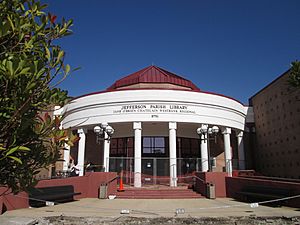
Public schools in Jefferson Parish are run by Jefferson Parish Public Schools. The Jefferson Parish Library system provides public libraries for everyone to use.
Many students in the parish have also attended private schools, especially Catholic schools. In 2014, over 25% of school-aged children in Jefferson Parish went to private schools. However, the number of students in private schools has slowly gone down. This is partly because more charter schools have opened, and the public schools have improved. Events like Hurricane Katrina and the 2008 recession also played a role.
Getting Around Jefferson Parish
Jefferson Parish has a good network of roads, including an interstate highway and many U.S. and state highways.
Major Roads
East Bank Roads
 Interstate 10: This highway connects the East Bank to St. Charles Parish (upriver) and New Orleans (downriver).
Interstate 10: This highway connects the East Bank to St. Charles Parish (upriver) and New Orleans (downriver). U.S. Highway 61: Also connects the East Bank to St. Charles Parish and New Orleans.
U.S. Highway 61: Also connects the East Bank to St. Charles Parish and New Orleans. U.S. Highway 90: This road links the East Bank to the West Bank using the Huey P. Long Bridge. It also goes to New Orleans.
U.S. Highway 90: This road links the East Bank to the West Bank using the Huey P. Long Bridge. It also goes to New Orleans.- Lake Pontchartrain Causeway: This very long bridge connects the East Bank to St. Tammany Parish across Lake Pontchartrain.
West Bank Roads
 U.S. Highway 90: Connects the West Bank to the East Bank via the Huey P. Long Bridge and also goes to St. Charles Parish.
U.S. Highway 90: Connects the West Bank to the East Bank via the Huey P. Long Bridge and also goes to St. Charles Parish.
 U.S. Highway 90 Business: Connects the West Bank to New Orleans.
U.S. Highway 90 Business: Connects the West Bank to New Orleans. Louisiana Highway 18: Connects the West Bank to St. Charles Parish.
Louisiana Highway 18: Connects the West Bank to St. Charles Parish. Louisiana Highway 23: Connects the West Bank to Plaquemines Parish.
Louisiana Highway 23: Connects the West Bank to Plaquemines Parish. Louisiana Highway 45: This highway connects the West Bank to towns in the southern part of Jefferson Parish, like Jean Lafitte and Barataria.
Louisiana Highway 45: This highway connects the West Bank to towns in the southern part of Jefferson Parish, like Jean Lafitte and Barataria.
Grand Isle Road
 Louisiana Highway 1: This road connects Grand Isle to Lafourche Parish.
Louisiana Highway 1: This road connects Grand Isle to Lafourche Parish.
Public Transportation
Jefferson Parish Transit (also known as JeT) offers bus routes and other services to help people get around the parish. They even have a special "Hurricane Evacuation System" to help people leave the area safely if a big hurricane is coming.
Famous People from Jefferson Parish
Many interesting people have connections to Jefferson Parish, including:
- Amy Coney Barrett: A current justice on the Supreme Court of the United States.
- Ellen DeGeneres: A well-known comedian, TV host, and actress, born in Jefferson Parish.
- Mel Ott: A famous baseball player who is in the Major League Baseball Hall of Fame. He was born in Gretna.
- Salman "Sal" Khan: The founder of Khan Academy, a popular online learning platform.
- Steven Seagal: An actor who has also served as a Reserve Deputy Chief in Jefferson Parish.
- David C. Treen: A former U.S. Congressman and governor of Louisiana.
See also
 In Spanish: Parroquia de Jefferson para niños
In Spanish: Parroquia de Jefferson para niños



